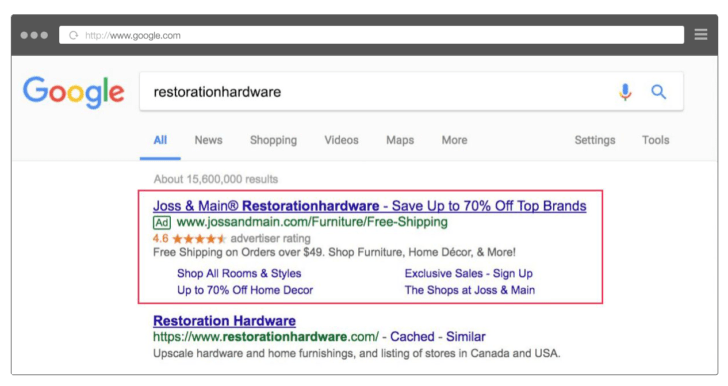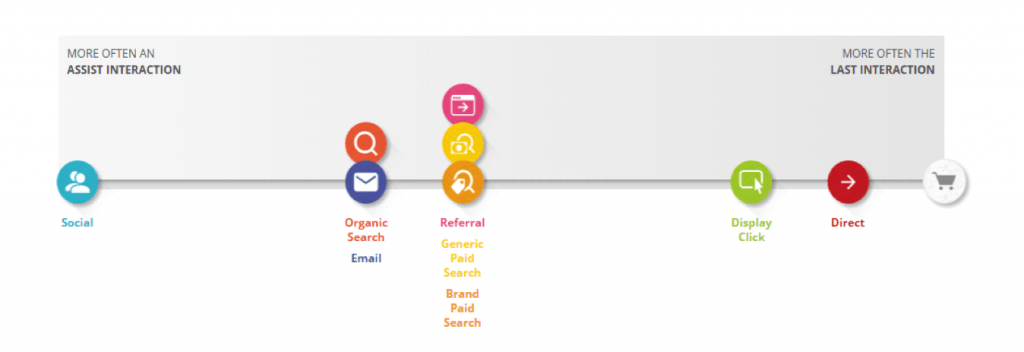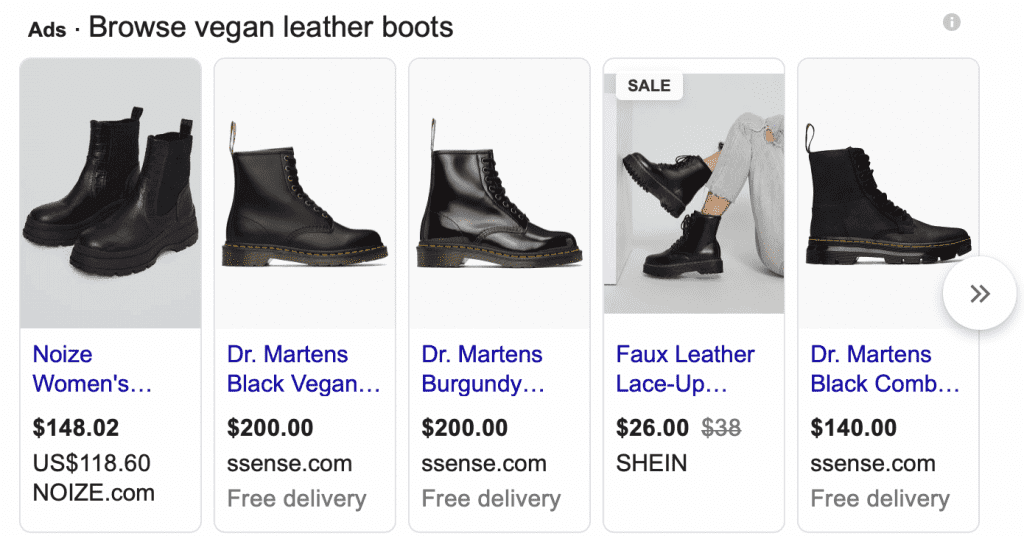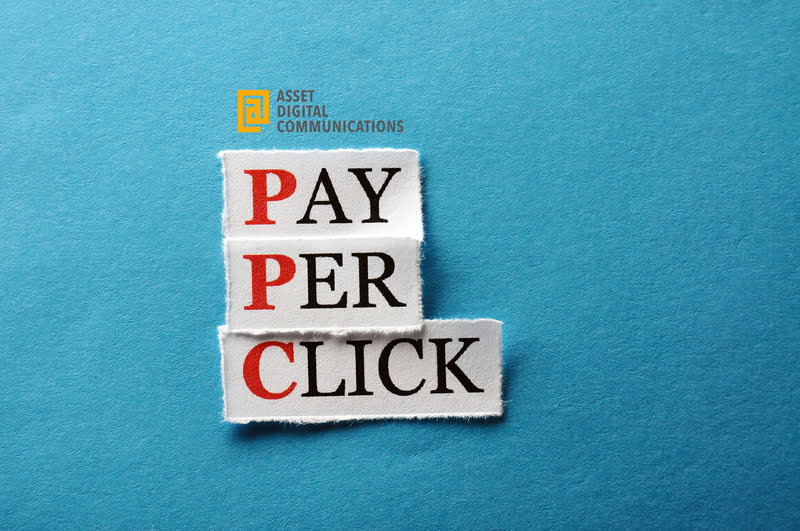8 Types of PPC Management Services
Businesses make $2 from every $1 spent on PPC campaigns and PPC visitors are 50% more likely to convert as leads than organic traffic! This makes pay-per-click (PPC) management services a tactic that you just can’t afford to exclude from your marketing strategy.
Where do you begin on your PPC management journey? In this guide, we’ll talk about the 6 types of PPC management services you can use to drive more awareness and leads from your digital campaigns –
Paid Search – The Gateway to the Internet
Web search is the No. 1 driver of traffic to websites.
Not only does it send more traffic but also better-quality traffic because the search is driven by the searcher’s intent. Paid search can help you tap into that search intent and display your digital ads on top of the SERP.
Paid search ads are text ads that appear on the top and bottom of the search engine results page and they’re identified by the word ‘Ad’ right next to them. But it’s not as easy as just submitting your ad on Google or Bing.

Your ad placement is determined by various factors such as your –
- Bid amount
- Quality score
- Keywords
- Landing page
The confluence of these factors helps a search engine determine how relevant your ad might be for a searcher.
If you’ve already got a paid search campaign running, a PPC audit can help determine optimizations to improve its performance.
There’s a lot more that goes on behind the scenes and marketers don’t joke when they say paid search is a science of its own!
Learn How PPC Campaign Can Benefit Your Business
How Does PPC Work and What Makes It So Good?
Pay-per-click or PPC is a part of Search Engine Marketing or SEM. In PPC, you only pay when someone interacts with your ad via impressions and clicks.
Most commonly associated with the ads you see on search engine results pages or SERPs, PPC is also found in paid ads on social media.
Having an ad on the first page of search results is not as simple as paying for it. Google has Ad Auction, an automated process to determine the relevance and validity of an ad.
In an Ad auction, you bid on keywords that you want your ads to be triggered on. For example, you would bid on the keyword ‘gym equipment’ if you are a gym equipment retailer.
Ad auction determines the order in which ads appear and what those ads are.
Because the bidding is so keyword-dependent, it has spawned the rise of keyword research tools that help you find the right keywords to bid upon.
Now that we know how PPC works, let’s understand what makes it so good and the many benefits it has.
The biggest benefit of PPC is that you can track almost any kind of conversion goal. You can set highly specific goals, fine-tune your targeting, and get rich reports to know whether your campaigns are working.
This makes PPC a powerful tool that can streamline your website traffic to achieve business and marketing goals.
PPC can do a lot of this heavy lifting for nurturing the middle of the funnel by chasing goals such as app downloads, collateral downloads, newsletter subscriptions, and more.
If you are running a PPC campaign through Google, the level of measurement and tracking is very detailed. This can help you understand exactly how your ad dollars are spent.
With Google Ads and Google Analytics, you can see highly detailed performance metrics such as impressions, clicks, Quality Score, Click Through Rates, and much more!
While having access to all this data is great, understanding it can be a bit difficult. Businesses often consider taking the help of PPC specialists to take care of the technical side of campaigns.
PPC also fits snugly with all your other marketing channels. May it be SEO, where often the same audience is targeted for impressions and garnering traffic.
Or it can even be re-marketing, where you might find that PPC is a cheaper option if you want to run re-marketing ads. PPC in this case can help you target lower funnel audiences.
A lot of the data that you gather using PPC, like keywords, clicks, and impressions can also help you with your SEO efforts!
1. Social Ads – The Catalyst in PPC Management Services
Unlike paid search, social PPC ads are determined by the advertiser rather than the search intent.
More than that, social PPC creates deeper levels of engagement and can act as a catalyst in your sales cycle. More than a click to the landing page you can also get a like, follow, re-tweet, share, or pin.
It’s great for brand awareness too. A lost sale does not mean lost business forever. You still end up with brand awareness and mindshare.

Different social platforms are well suited to different audience profiles. A B2B prospect might visit LinkedIn to consume professional content but she might also visit Instagram on the weekends to catch up on her friends.
So, there’s merit in advertising on LinkedIn, Twitter, Facebook, Pinterest, Instagram and more, but with the right content mix.
2. Display Ads – why write when you can show!
Instead of being all text, display ads have photos in them and appear on a search engine’s partner networks. Google Display Network or GDN is one of the most popular display networks out there.
The GDN network spans more than 2 million websites and will show your ads to a targeted audience. You can be conscious of your advertising approach by blacklisting certain websites and selecting different website tiers where you want your ads to appear.
And it offers a lot of options like – Gmail ads, responsive display ads, engagement ads and uploaded image ads. Basis your inputs GDN also auto-optimizes the ad performance over time. This makes GDN the most popular choice for display Ads.
The other option is programmatic display ads, which operate at a much larger scale than GDN and offer more reach if used wisely. The only drawback is that it is complex!
Programmatic display ads run on ad exchanges which means more reach but it also needs a more hands-on approach to tweak those ads and track your campaign performance. For example, you can have an ad display on a person’s mobile phone when they leave a physical store!
All of this makes programmatic display ads more expensive but most of these costs can be offset by working with a smart agency partner who owns the platforms and can do the complex legwork on your behalf.
3. Video Ads – storytelling at its best
The little video ad you see right before your YouTube video starts are called in-stream ads. Whether you can skip it or not, you’ve just watched a sponsored video.
Considering that YouTube is the most popular social media platform on the planet, video PPC ads are a no brainer. People also use YouTube as a search engine and can find your ads depending upon their search intent.
If you already have videos on your YouTube channel you are halfway there. Start leveraging them as assets for your video campaign. Target them to the right people, and exclude them from the websites you don’t want them on.
You control where your ads appear!
Same as with display ads, you can also use programmatic video ads to reach greater scale and fine-tune your targeting.
4. Re-marketing – Never Lose a Lead Again
Many people visit your website but they don’t convert. They might need more time or information to make a decision. Re-marketing is a method to target these visitors again and provide them with the information they need to make that final decision.
Re-marketing is an effective PPC management service to get leads to consider your brand again. You can segment visitor’s basis the pages they visit and run separate re-marketing ads for each segment.
You can re-market on Google, Facebook and more. Each platform has its pros and cons but the fundamentals remain the same.
You can also use dynamic re-marketing ads, which are customized for each impression basis the content a user has previously seen. What’s different with dynamic re-marketing is that Google creates dynamic ad layouts taking into consideration multiple factors.
The factors can be a user’s website behaviour, your price range and the image and text you provided.
5. E-Commerce Ads to Promote Your Store
If you’ve got an online store you cannot do without e-commerce PPC ads. These ads target shoppers who are at the bottom of the funnel and are ready to make the purchase.
Just like with other PPC options, there are many platforms you can run your e-commerce PPC ads on. The most popular are Google Product Listing Ads, Facebook Catalog Ads and Amazon Ads.
Regardless of the platform, a good practice is to keep your shopping feeds updated. Each ad platform uses your shopping feed to advertise your products. Policies around feeds keep changing and it’s always good to be on your toes about it.
Optimize your e-commerce ads by diversifying the types of ads, creating ad extensions and adding negative words. There are a lot of permutations and combinations to experiment with and that’s where a specialist agency can help make sense of these things.
6. Shopping Ads That Fill Up the Cart!
The most popular PPC shopping ads are the ones you’ve already seen. These are the ones that pop up on the first page of search results when you’re looking for something like ‘vegan leather boots’ or ‘bedroom wall art’.
These are Google Shopping Ads that appear in a carousel format and give a ‘window-shopping’ feel to the search experience.
 These ads appear on the top and before the main search results and are a quick way to look at the available products from different brands.
These ads appear on the top and before the main search results and are a quick way to look at the available products from different brands.
Google Shopping Ads also allow customizations in the form of signs on top of your ads such as price drops, star ratings, or even special offers such as free shipping.
7. Local Ads for Neighbourhood Stores
Local ads are a great way to further fine-tune your targeting down to a zip code.
This is one of the most exclusive PPC ads and is open to only a few businesses such as plumbers, electricians, tax services, HVAC companies, locksmiths, etc.
The local service ads are different from traditional Google ads and appear mainly when there is a specific local search query that includes a zip code, neighborhood name or city.
 Local ads can help you get local ads that have a higher chance of buying from you again!
Local ads can help you get local ads that have a higher chance of buying from you again!
8. Accelerate Your Campaigns With Gmail Sponsored Ads
Gmail sponsored ads appear in Gmail and they can easily be created with an existing Google Ads account.
These ads appear like any other email in your Gmail inbox but have the word ‘Ad’ next to them. Upon clicking, the user sees a more expanded version of your ad.
Like any other email, you can then add a link to your website to direct traffic. Gmail ads are a great way to create brand awareness and target top of the funnel customers.
You can even get data on the number of people who saved your message for later, how many times it was forwarded, and even clicks to track open rates and how many landed on your website.
At the end of the day, PPC can work across the funnel and at each stage of the buyer’s journey. There are many options to choose from but always remember to meet your customers where they are not where you want them to be!
Suggested Reads For You



